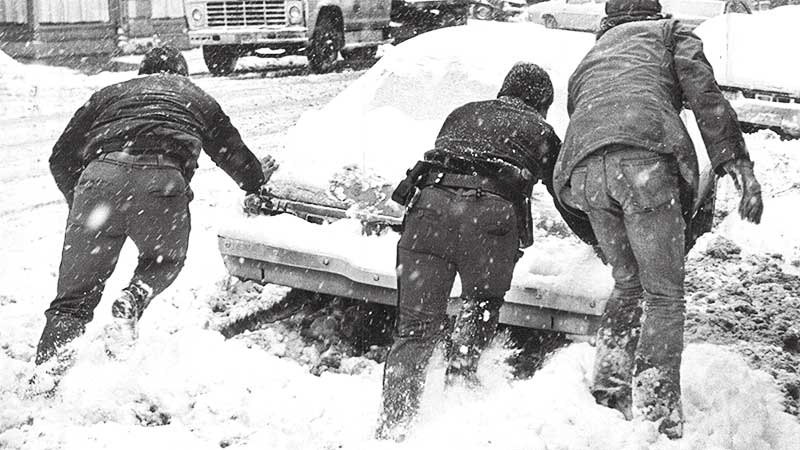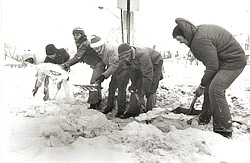1978’s ‘perfect storm’ unforgettable in Valley

SEE ALSO: Youngstown council committee to meet today about snow removal
By JORDYN GRZELEWSKI
jgrzelewski@vindy.com
YOUNGSTOWN
First came the rain.
Then, temperatures plummeted nearly 30 degrees in the span of a few hours.
Next came winds gusting up to 65 mph.
Blizzard of 1978

Water crystallized into ice. Snow fell, and then it was blown by the heavy winds into towering, impenetrable snowbanks.
Life across much of Ohio, and other parts of the U.S., came to a days-long standstill.
Forty years later, the Blizzard of 1978 remains unforgettable for Mahoning Valley residents who lived through the three-day storm.
LIKE A HURRICANE IN A SNOWSTORM
The Jan. 26, 1978 The Vindicator reported: “Arctic air from northern Canada collided with warm air over Ohio today, creating blizzard conditions, causing widespread wind damage and prompting Gov. James Rhodes to declare a state of emergency.”
Between 4 and 7 a.m. that morning, the temperature dropped from 43 degrees to 16 – “making the area a no man’s land of icy highways and blowing snow,” the paper reported.
Around the same time, “blizzard-force winds” tore through the area, creating a wind chill factor of 30 to 40 degrees below zero.
Early that morning, about half an inch of snow fell, with a few more inches forecasted.
It wasn’t so much the amount of snow, but the high winds and low wind chills that made the Blizzard of ‘78 so memorable, meteorologists say.
“The wind was the equivalent of a Category 3 hurricane,” said Eric Wilhelm, chief meteorologist for 21 WFMJ-TV, The Vindicator’s broadcast partner. “The wind gusts around here were easily upwards of 50 to 65 mph. It was definitely a historic storm.”
“It’s like having a hurricane in the middle of a snowstorm,” added Zach Sefcovic, a meteorologist with the National Weather Service in Cleveland. “We ended up recording the lowest atmospheric pressure in Ohio history. The lower the pressure, the more intense the winds are.”
In Youngstown, the lowest barometric pressure reading during the blizzard was 28.39 inches, which is still a record, he said. The state record was during the blizzard in Cleveland at 28.28 inches.
About 5 to 10 inches of snow fell, Sefcovic said.
“The snow was of little consequence because the winds created incredible snowdrifts of several feet,” he said. “It caused extreme white-out conditions. The impact on the roadways continued through [Jan. 30]. Travel was impossible in places and people were digging out of the snowdrifts for days.”
Also accompanying the winds was extreme cold, Sefcovic said.
“By the early morning of the 26th, temperatures were at zero and wind chills were at negative 40,” he said. “This was the worst winter storm to impact the area in terms of wind and snowdrifts. It’s the most notable storm that everything is compared to. It shut down Northeast Ohio for four or five days.”
WREAKING HAVOC
The wind toppled power lines, telephone lines, and trees, and smashed through windows and roofs.
The Vindicator chronicled damage throughout the Valley, including to the Meridian Auto Body Shop on Mahoning Avenue, Hills Department Store at Lincoln Knolls Plaza, and the Gray Drug Store at the Boardman Plaza. Parts of Warren Western Reserve High School’s and Niles McKinley High School’s roofs were ripped off.
Mail wasn’t delivered.
Every area school was closed.
More than 200 people in Trumbull County lost heat in their homes, and had to shelter in community halls, schools and fire stations.
Newton Falls was impacted particularly severely, with more than 100 residents evacuated to a local bank and community center.
The Vindicator reported Friday, Jan. 28: “It was a day of coping in the Newton Falls area. Thursday morning, most of the city’s power lines went dead, cutting the lights, stopping the furnaces and halting the municipal water pumps. Water was being tanked in by the National Guard.”
As of Thursday night, an estimated 150,000 residences and businesses across the state didn’t have power.
Thousands of people had be rescued from highways.
Rhodes reported that the governor’s office was getting 25 calls every five minutes, according to Vindicator articles.
CITY AT A STANDSTILL
The weather bureau put out an advisory telling people to stay home “unless absolutely necessary to go out,” the Vindicator reported.
For some, however, it was necessary. Among those who braved the storm were reporters and photographers who filled the newspaper with coverage of the storm’s impact.
Vindicator regional editor Ernie Brown Jr., at a time a reporter, recalled being sent out with a photographer to get storm stories. During the excursion, the pair witnessed people relying on one another to get through the blizzard.
“To help or be helped,” Brown’s Jan. 27 story read. “Many residents in Greater Youngstown found themselves in one or both situations yesterday.
“The weather’s capriciousness – rain, to begin with, then cold, 60 mph winds, swirling snow, live wires, trees that fell on houses, garages and cars – created no end of human suffering.”
It was not all suffering, though.
Vindicator crime reporter Joe Gorman was 11 and living on the city’s West Side at the time.
He remembers playing tackle football in the street with his friends. There was enough snow to cushion someone’s fall, yet it was easier to move because the snow was packed down by cars.
He also recalled sled-riding on the hill at the Mahoning Valley Sanitary District Reservoir on North Dunlap Avenue, and his father placing a light inside the hood of his car to keep the battery warm.
Also out and about during the blizzard was city police Detective Sgt. John Perdue, who at the time was a patrolman.
“The city was at a standstill. We were the only cars that were really able to move,” Perdue said. “We had to break out what we call the heavy-duty vehicles – we had these big armored-type vehicles we used that plowed through the snow.”
Perdue said not many calls came in during the storm, and those police did receive were mostly for people stuck on the roads.
“A lot of people were stranded,” he said.
Tim Filipovich, who works at Youngstown City Schools and at the time was a Brookfield teacher, tried to make the most of his time off from school. While most people remained indoors, Filipovich and a friend decided to go ice fishing at Pymatuning Lake.
“Everybody thought we were crazy – and we were,” Filipovich said.
“As you sat down, the wind was blowing at your back,” he said. “After being there for two hours, you had the beginning of an igloo forming around you.”
Filipovich remembers the cold as so brutal, you couldn’t leave even an inch of skin exposed.
On the upside, he does remember making some catches.
“It didn’t seem to bother the fish,” he said.
Contributor: Staff reporter David Skolnick
 43
43
